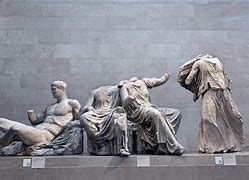Art and Who Truly Owns it.

It’s always fun to go to an art museum and discover the history behind brilliant pieces of artwork. Art museums allow us to learn about new cultures, get a glimpse into the distant past, and understand the emotions of people that were alive during these historical periods. However, art museums have a dark history tied to how they obtain and keep hold of the artwork within their walls. Whether it’s the British Museum of Art or the National Gallery of Art, most modern art Museums create a façade of wonder and learning that stands upon a pillar of colonialism and death.
If you have ever heard about stolen artwork, you have probably heard about the Elgin Marbles, also known as the Parthenon Marbles. If you go to the British Museum of Art, they will tell you the Elgin Marbles were discovered by Thomas Bruce, 7th Earl of Elgin, hence the name. What they won’t tell you is that in 1801, Lord Elgin obtained a permit to remove material from the Parthenon and its surrounding structures. Pieces were also removed from the Erechtheion, the Propylaia, and the Temple of Athena Nike, all inside the Acropolis. Even at the time this was extremely controversial, disputes arising over the legitimacy and legality of the removal permit.
Greece has worked extremely hard to obtain the Parthenon Marbles back and have been requesting the return of the stones since their independence in 1832. Britain have refused to return the stones, along with other treasures from countries such as Nigeria and Ethiopia, often citing legislation that bans its museums from permanently disposing of their collections. Its even more insulting when Britain claims that the marbles are a British national treasure.
This, and many other cases, spark the debate over who should own artwork. Most people agree that it should be the place of origin, like how the British population agrees that the Elgin Marbles should be returned to Greece. However, it is simply not as easy to return artwork as people think. In the case of the Elgin Marbles, laws that declare Britain as the legal owners as the Marbles would have to be rewritten to give them back. However, it’s naïve to not acknowledge that Britain put this law in place themselves, and to use it as some excuse for why they can’t return the artwork is not only insulting to Greece but other places around the world whose priceless artifacts are housed in Britain. The British government believes that the museum is the right home for the many pieces of artwork as it makes them accessible to a larger number of people and, as a leading museum in one of the world’s most global cities, has the best facilities for their upkeep. This excuse glosses over the 2019 incident where a leak in the Greek exhibit inside the British Museum of Art caused mold or when the Elgin Marbles itself was damaged after a botched cleaning attempt.
Britain is making some change however, with the University of Cambridge returning a bronze stature of a cockerel to Nigeria’s National Commission for Museums and Monuments. This was followed by the University of Aberdeen returning a sculpture depicting the head of a Benin king to Nigeria. France and Germany have also taken efforts to repatriate similar objects. None of these moves, however, have motivated the British Museum of Art to return even one of their stolen artifacts. The biggest reason they don’t want to is money. The British Museum of Art alone holds around 73,000 pieces of African artwork, and for them to return each piece would case a huge cut in revenue.
Overall, the conversation of stolen artwork is something that should be addressed, especially by Britain themselves, and we as the consumer should hold these owners of museums accountable when it comes to how they obtain the artwork we enjoy so much.


